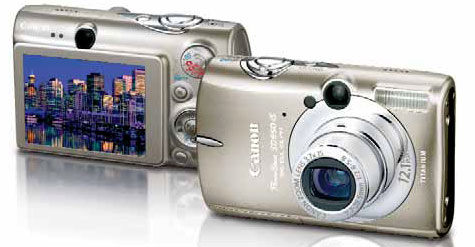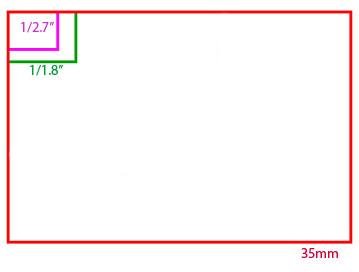The Digital Sensor: A Guide to Understanding Digital Cameras
by Wesley Fink on April 21, 2008 1:00 AM EST- Posted in
- Digital Camera
A few years ago, all digital cameras were "point and shoot" and they were very expensive compared to film cameras. Digital prices dropped rather quickly as digital sensor resolution continued to increase. Soon enough digital "point-and-shoot" cameras were available at every price point from a basic snapshot to the more serious models geared at the prosumer market.
At the dawn of the consumer digital SLR in 1999, a 2.7MP (megapixel) DSLR with an APS C sensor was considered an incredible buy at $5000. Tremendous growth in market share and the falling prices of DSLR cameras in the years since have created new buying options for those shopping for an upgrade to an existing camera or even a first camera. This has been particularly true in the last couple of years. All of the old reasons to own a point and shoot instead - with lower cost leading the way - have fallen by the wayside as the DSLR has continued to evolve and become both very price competitive with P&S and much easier to use.
However, many new DSLR buyers are walking into a brave new world with blinders on. The first question everyone should ask is why should you buy a DSLR instead of a point and shoot? Are there real technical advantages to DSLRs? After all the ads for point-and-shoots are hyping the same range of sensor resolutions that you will find in digital SLR cameras, so why buy a DSLR? The answer to that question is what really prompted this article.

Yes, you can buy 10MP and 12MP point-and-shoot cameras - the same megapixel range as current mainstream DLSR cameras - but they cannot possibly produce the same image quality over the same wide range of shooting conditions as a digital SLR. The reason why is simple physics, as the point-and-shoot sensors are much smaller than sensors in a DSLR. In fact, that is also the very reason why point-and-shoot digital cameras were the only choices in the market for a few years.
The early sensors were much lower megapixel resolutions, far too low to begin to compete with film photography. Photo hobbyists saw few advantages in moving to a low resolution system since the reason they used an SLR was high image quality. It wasn't until resolutions reached the 2-4MP range that there was any interest in a digital SLR.

The early sensors were also very small, developed primarily for video usage. The 1/2.7" compact sensor is 5.3x4.0mm and the larger 1/1.8" is 7.2x5.3mm - compared to 35mm at 24x36mm. These typical compact sensors are just a tiny fraction the size of 35mm sensors, and these sensors were among the largest available in P&S digital cameras. Some tried to develop proprietary systems based on a smaller sensor size with more compact lenses, but nothing caught on in the industry. The cost of early sensors was also astronomical, making the early digital SLR cameras only useful for production, high volume photography where the cost could be justified.
Finally, early digital development saw sensor resolution and size in constant evolution. With sensor size changing with each new generation, it was much easier to design a point-and-shoot camera around each new sensor generation using a dedicated and non-interchangeable lens. Until sensor size stabilized, a digital SLR that used either existing 35mm lens systems or a new "standard size" was not practical.










72 Comments
View All Comments
gheinonen - Tuesday, October 14, 2008 - link
I am curious why that CMOS sensor in the high end Canon camera body has excellent low black noise compared to the images from a Fuji Pro S3/S5 with its Super CCD? I have used Fuji Pros since 2004 and have discovered that my black details in low light situations include a lot of random color noise which I do not see when reviewing images from the 1DS Mark2 body. What does the Canon body do to eliminate the random color noise in low light black detail? Is it the CMOS Sensor? Is it the body processing?Separately, the white detail on my Fuji Pro S3 has such expanded dynamic range that I can shoot higher exposures and then lower the exposure back to normal in software and it appears to lower or mask the noise floor in the same way that Dolby Noise Reduction works for audio.
bonedaddy - Wednesday, April 30, 2008 - link
I've been a 35 mm fan for years, and have a significant investment including multiple lenses, macro, ring lights etc. For trips etc the smaller cameras seemed fine--always had small 35 mm, for instance. However, re the digital small cameras, the amount of compression is really disappointing.Is my only choice to go back to a body/lens SLR if I want wide angle and telephoto capability AND good resolution?
Midwayman - Thursday, May 1, 2008 - link
No. But if you want wide/tele and really good high iso performance a SLR is where you need to be. PS camera have alway been a compromise. Small 35mm film cameras had focus issues, and lens issues too. Plus most people use iso 200-400 film which has reasonable quality even in a PS digital camera. The biggest difference is now we're blowing up the picture to 1:1 on our monitors and can see the quality defects easily. I bet if you printed your old compact photos at something like 16x20 you'd probably be unhappy with them too. That's the sort of scale we're looking at on our monitors zoomed in.CyniCat - Thursday, April 24, 2008 - link
Good article, but one glaring mistake: you claimed Sony was the first to make a 12+Mpixel CMOS sensor. I think you meant the first AFTER Canon - the 5D, with its 12.8Mpixel sensor, was on the market in 2005, and the 1Ds Mark II, with a 16Mp sensor, was on the market earlier than that.On a different front, I thought the Nikon D3 was using a Sony sensor, not a Nikon?
Wesley Fink - Friday, April 25, 2008 - link
The 5D and 1Ds II and III are full-frame sensors. The Sony was the first consumer (read affordable) APS-C sensor. Canon now has their own 12 megapixel consumer sensor in the XSi, which we are now reviewing.Nikon did their own designs for the D3 sensor, but they do not, to our knowledge, have the capabilities to manufacturer that sensor. Sony has manufactured sensors for them in the past and present with the D300, D60, D80, and others.
Since the new full-frame is CMOS it is likely manufactured by Sony, or possibley Samsung. Sony and Samsung (who make the Pentax 14.6 megapixel sensor) jointly own several patents on CMOS manufcaturing technology.
Wesley Fink - Friday, April 25, 2008 - link
That should read the read "First consumer 12 megapixel APS-C sensor". As mentioned several times in the article Canon pioneered CMOS technology in a consumer DSLR with the Digital Rebel.Midwayman - Wednesday, April 23, 2008 - link
This article complete skips of fuji's fantastic super CCD technology. Its not really a traditional Bayar array, nor a foveon. True they don't produce a interchangeable lens SLR but they do make prosumer SLR's with their sensor. Also the very notable fuji f30 series cameras were made with this sensor. It was a true triumph in PS camera high iso usability.ElFenix - Thursday, April 24, 2008 - link
fuji makes interchangeable lens SLRs with Nikon F mounts.Midwayman - Friday, April 25, 2008 - link
Hell, then there is no excuse for it not to be included in this article. Especially when it quite clearly states there are no other sensor options at one point.Wesley Fink - Friday, April 25, 2008 - link
There will always be fans of one technology or another who feel slighted. I apologize for that, but Fuji is still basically a Bayer sensor with a differnt pixel shape. I have added the following to the Bayer vs. Foveon page to make Fuji fans a bit happier:"FujiFilm produces one current DSLR with a variant of Bayer technology. It is called the Fuji S5 Pro and is basically a Nikon D200 body with a Fuji Super CCD sensor. The Fuji S5 Pro uses the Nikon lens mount. The Super CCD still uses red, blue and geen pixels in the same standard Bayer ratios. However, the shape of the pixel is hexagonal rather than the squate or rectangular pixels in other Bayer arrays. In the latest version Fuji also added smaller photosites between the normal pixels to gather "dynamic range" data.
Fuji has updated the camera body from the S3 to the S5 in the past year, but the sensor has not been updated for more than 3 years. The current Super CCD is still a 6.3 megapixel sensor, but Fuji specifes it as a 12.3 megapixel due to the addition fo the tiny "brightness" pixels. Tests indicate the true resolution is more comparable to an 8 to 10 megapixel sensor from competitors. The Fuji sensor is still basically a Bayer sensor with a different shape for pixels."
We can probably now all argue whether the Fuji Super CCD is really a Bayer variant or not. It certainly appears that way to me, and as a CCD instead of a CMOS sensor it is need of a serious update if it is to continue as a player in the DSLR market.